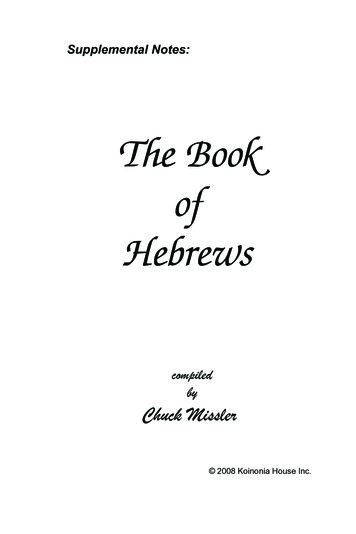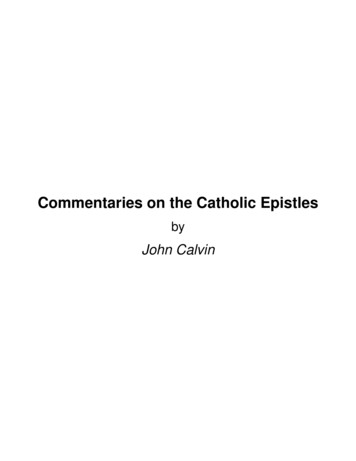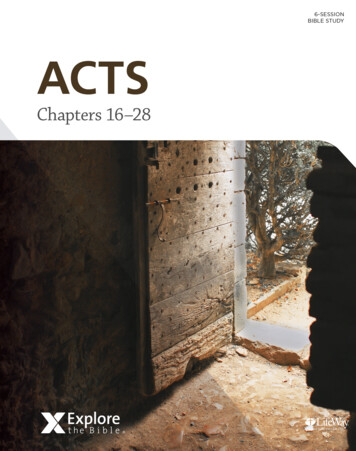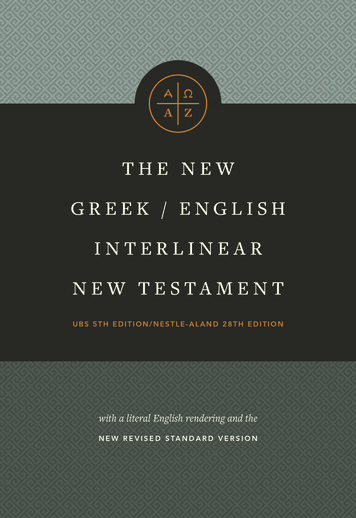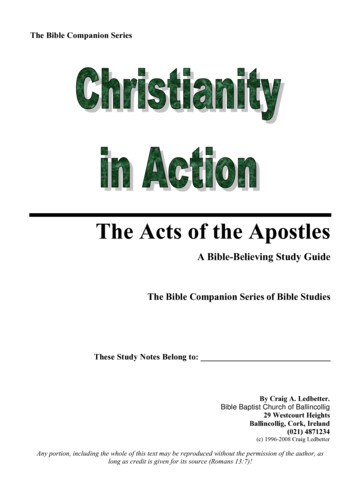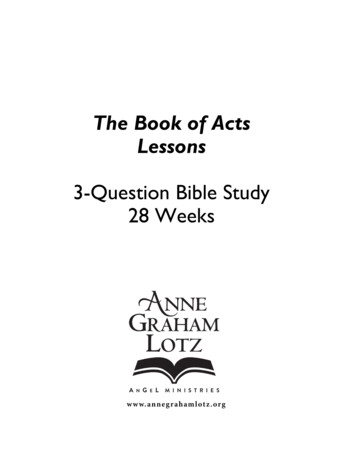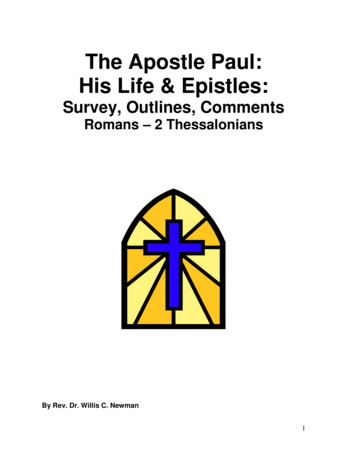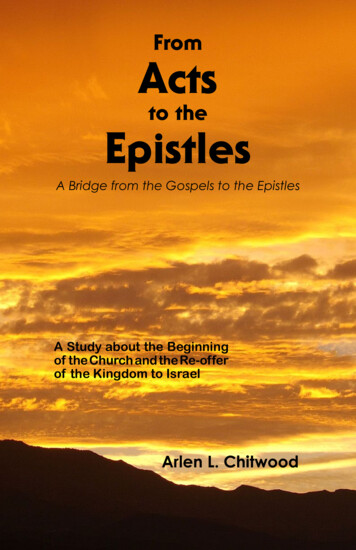
Transcription
FromActsto theEpistlesA Bridge from the Gospels to the EpistlesA Study about the Beginningof the Church and the Re-offerof the Kingdom to IsraelArlen L. Chitwood
Scripture deals centrally with man in relation to a province withinthe kingdom of God — this earth. This province forms a kingdom withinthe overall kingdom of God, and man was created to rule this kingdom.The kingdom which man was created to rule has two spheres — anearthly sphere, and a heavenly sphere. And the kingdom is ruled fromthe heavens over the domain — from the heavens over the earth.God rules the whole of His universal kingdom in this manner (from aplace in the heavens over His universal kingdom), and this is the mannerin which He has established the governmental rule of individual provincesin His kingdom as well.Both spheres of the kingdom are clearly seen in the Old Testament(e.g., Dan. 6:1ff; 10:13ff); but, in relation to man, the Old Testament dealsmore specifically with the earthly sphere, and the New Testament dealsmore specifically with the heavenly sphere.Accordingly, this book, From Acts to the Epistles, has to do with manin relation to the heavenly sphere of the kingdom, not the earthly sphere.And this would be easy to understand through noting the clearly revealedcontent of the New Testament as a whole.The central theme of the four Gospels (introduced in the Old Testament) has to do with the offer of the kingdom of the heavens to Israel,ending with Israelʼs rejection of the King and the Kingdom, resulting in theKing being crucified.The central theme of the Book of Acts (introduced in the Gospels) has todo with the inception and early years of the Church, along with a re-offer ofthe kingdom of the heavens to Israel, ending with Israelʼs continued rejection.The central theme of the Epistles (introduced in Acts) has to do withthe offer of the kingdom of the heavens to Christians, resulting in readyacceptance at first, but later in an ever-increasing apostasy.And the Book of Revelation forms a climax to the entire matter, outlining events which will occur at the conclusion of this present dispensation.The book closes with the return of Christ in all His glory, the overthrow ofGentile world power, the ushering in of the Messianic Kingdom (with bothits heavenly and earthly spheres), and the beginning of the eternal ageswhich follow.
IntroductionFromActsto theEpistlesA Bridge from the Gospels to the Epistlesii
iiFROM ACTS TO THE EPISTLESii
IntroductionFromActsto theEpistlesA Bridge from the Gospels to the EpistlesbyArlen L. ChitwoodTheLamp Broadcast, Inc.225 S. Cottonwood Ranch RoadCottonwood, Arizona 86326or74798 South 4710 RoadWestville, Oklahoma 74965www.lampbroadcast.orgOriginal Printing 1998Revised 2012, 2019iiiiii
ivFROM ACTS TO THE EPISTLESiv
IntroductionvCONTENTSFOREWORD . . . . . . . . . . . . . . . . . . . . . . . . . . . . . . . . . .viiINTRODUCTION . . . . . . . . . . . . . . . . . . . . . . . . . . . . . . .ixI. CONTINUING FROM THE GOSPELS . . . . . . . . . . . . . .MESSAGE IN THE GOSPELS, CONTINUING IN ACTS1II. RESTORATION OF THE KINGDOM . . . . . . . . . . . . . . . 17THE KINGDOM, THE COMMISSION, ISRAEL & THE NATIONSIII. RESTORATION OF ALL THINGS . . . . . . . . . . . . . . . . . . 31HAD ISRAEL REPENTED WHEN ISRAEL DOES REPENT IV. ACCEPTANCE BY MANY . . . . . . . . . . . . . . . . . . . . . . . . 45MANY BELIEVED, BUT NOT THE NATIONV. REJECTION BY THE NATION . . . . . . . . . . . . . . . . . . . . 59THE SAME AS PREVIOUSLY SEEN IN THE GOSPELSVI. PAUL’S CONVERSION . . . . . . . . . . . . . . . . . . . . . . . . . 73A PROTOTYPE OF ISRAEL’S CONVERSION YET FUTUREVII. PAUL’S IMMEDIATE MESSAGE . . . . . . . . . . . . . . . . . . 87CONTINUING WITH THE RE-OFFER OF THE KINGDOMVIII. PAUL’S GOSPEL . . . . . . . . . . . . . . . . . . . . . . . . . . . . . . 101A MESSAGE TO THE SAVED REGARDING THE KINGDOMIX. LO, WE TURN TO THE GENTILES . . . . . . . . . . . . . . . . 115A THIRD AND FINAL TIME DURING THE RE-OFFERX. CENTRAL MESSAGE — THE PAULINE EPISTLES . . . 131PAUL’S GOSPEL, NOT THE GOSPEL OF GRACEXI. CENTRAL MESSAGE — THE GENERAL EPISTLES . . 145THE SAVING OF THE SOUL, THE LIFEXII. FROM JERUSALEM TO ROME . . . . . . . . . . . . . . . . . . . 159TURNING FROM ISRAEL TO THE GENTILESXIII. THE GOAL — THE BOOK OF REVELATION . . . . . . . . 173THE GOAL REALIZED IN THE MESSIANIC KINGDOMSCRIPTURE INDEX . . . . . . . . . . . . . . . . . . . . . . . . . . . . 191v
viFROM ACTS TO THE EPISTLESBy the Same Author —RUTHESTHERBY FAITHRUN TO WINLET US GO ONMOSES AND JOHNEND OF THE DAYSIN THE LORD’S DAYDISTANT HOOFBEATSTHE BRIDE IN GENESISSO GREAT SALVATIONSEARCH FOR THE BRIDEGOD'S FIRSTBORN SONSWE ARE ALMOST THERESIGNS IN JOHN’S GOSPELSALVATION OF THE SOULHAD YE BELIEVED MOSESTHE MOST HIGH RULETHTHE SPIRITUAL WARFARETHE STUDY OF SCRIPTUREFROM EGYPT TO CANAANCOMING IN HIS KINGDOMMYSTERY OF THE WOMANSEVEN, TEN GENERATIONSREDEEMED FOR A PURPOSEJUDGMENT SEAT OF CHRISTTHE RAPTURE AND BEYONDMYSTERIES OF THE KINGDOMPROPHECY ON MOUNT OLIVETNEVER AGAIN! OR YES, AGAIN!THE TIME OF JACOB’S TROUBLEBROUGHT FORTH FROM ABOVEISRAEL — FROM DEATH TO LIFEJUDE — ACTS OF THE APOSTATESO SLEEPER! ARISE, CALL ! (JONAH)THE TIME OF THE END (REVELATION)MIDDLE EAST PEACE — HOW? WHEN?SALVATION BY GRACE THROUGH FAITHMESSAGE IN THE GOSPELS, ACTS, EPISTLESISRAEL — WHAT DOES THE FUTURE HOLD?vi
IntroductionviiFOREWORDThe New Testament can be divided into four main sections —the four gospels, the Book of Acts, the twenty-one epistles, and theBook of Revelation. Each section forms an integral part of the NewTestament, and ONLY through seeing the relationship of the differentparts to the whole can the New Testament be properly understood.Then, viewing matters surrounding the first five books beginningthe New Testament from a more specific perspective, the Book ofActs, in a respect, forms a fifth gospel.And Acts, in a sequential arrangement of these opening five books,should follow Luke’s gospel, not John’s gospel. Acts picks up exactlywhere Luke left off in his gospel — with Christ’s post-resurrection ministryand His ascension, with Luke adding more details as he begins Acts.And, effecting the preceding, John’s gospel actually belongs atthe beginning of the New Testament, followed by Matthew, Mark,Luke, and Acts.John’s gospel, the only non-synoptic gospel, is the one gospel thatnot only begins exactly the same way Genesis begins but continueswith the same subject matter as well.Rearranging the gospels in this manner would allow each Testamentto begin and progress from this beginning point exactly the same way.(For more information on the preceding, refer to Chapter I, “Genesisand John,” in the author’s book, Moses and John.)If the first five books in the New Testament were arranged in thepreceding manner, one would not only have a Pentateuch beginningboth Testaments but a parallel beginning for both and a much bettertransition from the Old Testament to the New and from the gospelsthrough Acts into the epistles, allowing one to better understand thetransitional progression of the offer of the kingdom of the heavensfrom Israel to Christians.vii
viiiFROM ACTS TO THE EPISTLESIn the preceding respect, the New Testament is simply a continuation, unveiling, and outworking of that which was previously revealedin the Old Testament.Accordingly, the New CANNOT be properly understood apart from theOld. The Old will help explain and shed additional light upon that whichis being opened up in the New; and, in a corresponding respect, theNew, as well, will help open up and explain numerous things in the Old.The two Testaments are inseparably connected in this respect.Scripture, beginning in Genesis and concluding in Revelation,forms a divinely revealed interrelated and interdependent, progressiveunveiling of God’s plans and purposes. And NO part of this revelation— however large or however small — can stand alone. The WHOLEof the revelation MUST stand together, as a unit.Thus, beginning in the Book of Acts and continuing into the epistlesand on into the Book of Revelation necessitates continually goingback to the gospels, and behind that to various parts of the whole ofthe Old Testament.Placing the Book of Acts within its contextual setting — in relationto both that which precedes and that which follows — is the ONLYpossible way that it can be properly understood.The Book of Acts records a continuation of events from the gospelaccounts, occupying a place immediately following the four gospelson the one hand and a place leading into the twenty-one epistles onthe other.And this book provides that which man MUST know in order toproperly understand the progression of God’s plans and purposes asthey move from the gospels into the epistles, reaching their climax inthe Book of Revelation.viii
IntroductionixINTRODUCTIONThe Book of Acts forms the God-provided bridge between thegospels and the epistles, apart from which the epistles CANNOT beproperly understood.The gospels center around an offer of the kingdom of the heavensto Israel (the kingdom offered to and rejected by Israel, with Christthen announcing that the kingdom would be taken from Israel and“given to a nation bringing forth the fruits thereof” [Matt. 21:43]; andthis was followed by Israel’s crucifixion of her King [Matt. 27:22ff]).The Book of Acts centers around a re-offer of the kingdom of theheavens to Israel (beginning in chapter two [vv. 3ff] by the new entity[the “nation bringing forth the fruits thereof” (I Peter 2:9, 10)] calledinto existence immediately prior to that time to be the recipient of thatwhich Israel had rejected [1:5; 2:1, 2]).However, this re-offer (beginning in Acts 2 and continuing for aboutthe next three decades [33 A.D. to about 62 A.D.], seen throughoutthe Book of Acts) was rejected as well, with the offer ultimately beingcompletely taken from Israel and the nation set aside (Acts 28:28).And the epistles, though some were written prior to 62 A.D.,center around the offer of the kingdom of the heavens to an entirelynew entity, the one new man “in Christ,” called into existence to bethe recipient of that which Israel had rejected.The expression, “the kingdom of the heavens” (literal renderingfrom the Greek text, found thirty-two times in Matthewʼs gospel), issimply a reference to the rule of the heavens over the earth.As in Dan. 4:26, “the heavens do rule” — beginning with God, thesupreme Ruler over all, and progressing through an orderly structureof ruling angels (subordinate provincial rulers, with other angels possessing lesser positions of power and authority ruling under them),placed over provinces throughout the universe.ix
xFROM ACTS TO THE EPISTLESThus, there are TWO spheres of rulership in Godʼs kingdom —heavenly and earthly. And this would pertain not only to Godʼs universalkingdom as a whole but also to the various provinces in His kingdom.This is simply the way in which God established the whole ofHis universal government in the beginning (e.g., Job 1:6ff; 2:1ff). HeHimself rules from a place in the heavens over an ordered universe;and it is evident from the present form of the earthʼs government(existing in the same form which it will take yet future) that a rule ofthis nature — a rule from the heavens over the governed realm — isthe form which God, in the beginning, used when He established thegovernment throughout the different provinces of His kingdom as well.As this governmental rule pertains to the province upon whichwe live, Satan and his angels rule from a place in the heavens overthe earth; and this rule is revealed to take the form of powers in theheavens ruling through powers on the earth (Dan. 10:13-21; Luke4:6; Eph. 2:2; 3:10; 6:12).Again, “the heavens do rule.” Thatʼs the way matters in Godʼsordered government throughout the universe which He created havealways existed, continue to exist, and will always exist.(Note that it was the heavenly sphere of the kingdom which wastaken from Israel, NOT the earthly — the kingdom covenanted to David— which can NEVER be taken from the nation.)The Existing KingdomPast, Present, and FutureSatan, in his unfallen state, at a time in eternity past, was placedover the province upon which man presently resides — over the earth(Ezek. 28:14, 15). And a great host of ruling angels were placed insubordinate positions of power and authority with him.The day came though when Satan became dissatisfied with hisappointed position and rebelled against Godʼs supreme power andauthority. He sought to “exalt” (elevate) his throne above all the otherGod-appointed provincial rulers (angels ruling over other provinceselsewhere in the universe [worlds similar to the earth]) and “be likethe most High” (Isa. 14:13, 14).x
IntroductionxiBecause of this act, rather than elevating his throne, Satan became disqualified to rule even the province over which he had beenplaced. And this necessitated his subsequent removal, with anotherbeing appointed to take his place.But God didnʼt immediately act in this respect. Rather, God allowed Satan to continue holding his position, for a time.(A principle of Biblical government necessitates that an incumbentruler continue to hold his appointed position UNTIL his replacementis not only on the scene but ready to ascend the throne and hold thesceptre — something, for example, seen in the account of Saul andDavid in the Books of I, II Samuel:Saul was anointed king over Israel; but Saul disqualified himself byrefusing, as God had commanded, to destroy the Amalekites and all oftheir possessions [I Sam. 15:1ff], though Saul continued to reign. AndSaul would continue to reign until the one whom God had chosen toreplace him was not only on the scene but ready to ascend the throne.Then note that which the type, thus far, foreshadows:Satan was anointed king over the earth; but Satan disqualified himselfthrough seeking to extend his rule beyond his God-appointed position[Isa. 14:13, 14; Ezek. 28:14, 15], though Satan continued to reign. AndSatan would continue to reign until the One Whom God had chosen toreplace him was not only on the scene but ready to ascend the throne.In the type, shortly after God rejected Saul as Israel’s ruler, Godhad Samuel anoint David king over Israel [I Sam. 16:10-13]. Therewere then two anointed kings in Israel.But David didn’t immediately ascend the throne. Rather, he eventually found himself in a place out in the hills, separated from Saul and hiskingdom. And, during this time, certain faithful men joined themselvesto David and remained out in the hills with him.The day came when David was ready to ascend the throne, possessing a contingent of faithful men ready to rule with him. Then, Saulwas put down, his crown was taken and given to David, and David andhis faithful men moved in and took over the government.In the antitype, after God had rejected Satan as the earth’s ruler,God anointed His Son King over the earth [Ps. 45:6, 7, 16; Heb. 1:8, 9].There were then, and there are today, two anointed Kings over theearth. But God’s Son, as David in the type, didn’t immediately ascendthe throne. Rather, as David, Christ finds Himself in a place of exile,xi
xiiFROM ACTS TO THE EPISTLESseparated from the kingdom. And, as in David’s case, certain faithfulindividuals join themselves to Christ during this time, remaining in theplace of exile with Him.But the day is near at hand when matters will continue EXACTLYas seen in the type. Christ, in that day, as David in his day, will be readyto ascend the throne, possessing a contingent of faithful followers torule with Him. Then, Satan, as Saul, will be put down, his crown willbe taken and given to Christ, and Christ, with His faithful followers, willmove in and take over the government.)Satanʼs reign though, following his rebellion against Godʼs supremepower and authority, was quite different than it had been before thattime. Two-thirds of the angels originally holding positions of powerand authority over the earth with him refused to have a part in hisactions. Only one-third followed Satan (Rev. 12:4), and this left himwith a disrupted power structure in the government of his kingdom,completely out of line with that which God had originally established.And not only did a ruin of this nature exist in the governmental structureof his kingdom, but the physical state of his kingdom was reduced toa ruined condition as well (Gen. 1:2a).But the day came when God restored the physical kingdom andcreated man to replace the incumbent ruler. The physical creationwas restored over a six-day period, and man was created on the sixthday to “have dominion” — the dominion which Satan and his angelspossessed (Gen. 1:2b-28).Satan, knowing why man had been created, immediately soughta way to bring about manʼs disqualification. And this is what he accomplished through manʼs fall, an act which, for the time, preventedman from ascending the throne and allowed Satan to continue holdingthe sceptre.Following manʼs fall, Satan and his angels ruled over a restoredprovince, though under a curse because of manʼs sin (again ruined,though after a different fashion [Gen. 3:17, 18; cf. Rom. 8:19-22]). ButGod, far from being finished with man at this point, had only begun towork out His plans and purposes as they pertained to man and oneruined province in His kingdom.Redemption was to be provided in order that man, at a future pointxii
Introductionxiiiin time, could realize the purpose for his creation in the beginning.Man, a creation quite different than angels, created in the image andlikeness of God, was to be redeemed; and, as God originally intended,man was to one day hold the sceptre in Satanʼs stead (cf. Heb. 2:5).The Bible is a book of redemption, and this redemption encompasses far more than just manʼs eternal salvation wrought through faithin Godʼs provided Redeemer. It encompasses bringing redeemed manback into the position for which he was created. The purpose surrounding manʼs redemption is the same as the purpose surrounding manʼscreation in the beginning — “let them have dominion” (Gen. 1:26-28).And from the point of the fall in Genesis chapter three to the pointof this dominion being realized by man in Revelation chapter twenty,ALL of Godʼs redemptive purposes in Scripture are seen to move toward this end. ALL are seen to move toward man one day possessingdominion over the earth, in the stead of Satan and his angels.The “gifts and calling of God are without repentance [ʻwithout achange of mindʼ]” (Rom. 11:29). God is NOT going to change His mindconcerning the reason He called man into existence. Man WILL, manMUST, one day hold the sceptre, BUT in Godʼs time.In the meantime, Satan and his angels continue to occupy thethrone, continuing to rule from a place in the heavens over the earth.But the day is coming when there will be “war in heaven.” Michaeland his angels will fight against Satan and his angels, and Satan andhis angels will be “cast out,” anticipating Man — namely Christ andHis co-heirs — taking the kingdom and occupying these positions,exercising power and authority over the earth (Rev. 12:4, 7-10; cf.Rev. 2:26, 27; 11:15; 19:11-20:6).The Proffered KingdomIn the Gospels, Acts, and the EpistlesWhen John the Baptist, Jesus, and His disciples appeared to Israelwith the message, “Repent ye: for the kingdom of the heavens is at hand”(cf. Matt. 3:2; 4:17; 10:7), there could have been NO mistake concerningexactly what was meant. There was NO kingdom connected with theheavens and the earth outside of the one which God had established inthe beginning, the one over which a disqualified provincial angel ruled.xiii
xivFROM ACTS TO THE EPISTLESThe expression, “the kingdom of the heavens,” could ONLY bea reference to the kingdom ruled by Satan and his angels from aheavenly sphere, a kingdom to one day be ruled by Christ and Hisco-heirs from the same heavenly sphere.And the various things about this kingdom are things which theJewish people should have been fully aware of, for the structure of thekingdom as it exists throughout Manʼs Day and will exist at a futuretime is a clearly revealed subject of Old Testament revelation.This subject was introduced by Moses in Genesis. Moses spokeof that day when the seed of Abraham would exercise power andauthority over the earth from two spheres — heavenly and earthly(Gen. 22:17, 18); and this power and authority, according to Moses,would be realized in that future day when Godʼs Son exercises theMelchizedek priesthood (Gen. 14:18-22; cf. Ps. 110:1-4; Heb. 5-7).And, as previously shown, the form in which this kingdom existsthroughout Manʼs Day (and will exist in that coming day when Christ andHis co-heirs take the kingdom) is revealed in Daniel chapter ten (vv. 13-21).Through the ministry of John, Jesus, the Twelve, and the Seventy, “the kingdom of the heavens” was proffered to Israel. Throughthe ministry of these individuals, the nation of Israel was offered thesceptre held by Satan and his angels.Had Israel accepted the offer, Christ would have taken the kingdom;and Israel, with the nationʼs Messiah, would have held the sceptre.But Israel refused the offer, and the nation climaxed this refusalby crucifying the central person making the offer — Messiah Himself.Then, the Book of Acts details a re-offer of the kingdom of the heavensto Israel — beginning on the day of Pentecost (2:3ff) and terminatingabout thirty years later with Paul in Rome (28:28).Israel though again refused, and during this period God began Hiswork of forming the one new man “in Christ,” with those called out ofthis new man to one day occupy the heavenly positions in the kingdomwhich Israel had spurned.And once Israelʼs refusal in the re-offer of the kingdom reached aterminal point in Godʼs eyes, He set the nation aside and, with respectto the kingdom of the heavens, turned His attention completely towardthe new entity, the new creation “in Christ.”xiv
Introductionxv(The re-offer of the kingdom to Israel could continue ONLY as longas a saved generation of Jews remained on the scene [the generationalive on both sides of Calvary].Thus, once this generation of Jews began to pass off the scene,the re-offer of the kingdom could NO longer continue.The re-offer of the kingdom, in this respect, continued from 33 A.D.until about 62 A.D. Then, the re-offer, of necessity, ended.)This complete, overall picture of the offer of the kingdom of theheavens — whether to Israel (the offer and the re-offer), or to the onenew man “in Christ” — is how the gospels lead into Acts and howActs leads into the epistles, with Acts forming a bridge between thegospels and the epistles.As stated at the beginning, the gospels record the original offerof this kingdom to Israel, the Book of Acts records the re-offer of thiskingdom to Israel (as well as recording the inception of and a beginning offer of the kingdom to the Church), and the epistles record thecontinued offer (present offer) extended to Christians.All these things are dealt with at length throughout the thirteenchapters of this book, From Acts to the Epistles.Importance of the KingdomUnderstanding the Gospels, Acts, and the EpistlesThere can be no such thing as properly understanding the gospels,Acts, or the epistles apart from “the kingdom” being seen as central.Christʼs death on Calvary, effecting manʼs redemption, has to dowith the kingdom. Christ Himself, while enduring the sufferings surrounding Calvary, looked beyond these sufferings to the glory whichlay out ahead (Heb. 12:1, 2; cf. Luke 24:26).The coming kingdom, the Messianic Era, the time during which Christand His co-heirs will exercise power and authority over the earth for 1,000years, was that upon which Christ focused His attention while payingthe price for manʼs redemption. And it is this same kingdom upon whichHe has instructed redeemed man — in the midst of trials, testings, andsufferings — to focus his attention as well (I Peter 2:21; cf. Gen. 19:17).Manʼs redemption is inseparably connected with the coming king-xv
xviFROM ACTS TO THE EPISTLESdom of Christ. And though manʼs redemption is eternal in durationand connected with a continuing regality in the eternal ages beyondthe Messianic era, this is not where Scripture places the emphasis.The central focus in Scripture pertaining to manʼs present redemptionand future rule centers on the 1,000-year Messianic Era.(Regality exercised by man beyond the Messianic Era will extendout into the heavens beyond the new earth [Rev. 22:1-5]. This is a realmextending far beyond the present kingdom of the heavens, out whereSatan sought to extend his rule at a time in eternity past.Scripture though centers around man, the present earth, and thepresent kingdom. Scripture centers around man occupying this presentkingdom of the heavens ruled by Satan and his angels, with Christ and Hisco-heirs taking 1,000 years to bring order out of disorder [I Cor. 15:22-28].The eternal ages lying beyond are mentioned in Scripture only toan extent which will allow man to understand where God is going tocarry matters once order has been restored in the government of oneruined province in His universe.)Thus, the central purpose presented in Scripture surroundingmanʼs redemption is that man might ultimately occupy the position forwhich he was created — to rule and to reign over this earth.This is something which cannot be overemphasized. And tospeak of manʼs redemption apart from the purpose surrounding manʼscreation, which resulted in his fall, necessitating his redemption, is toNOT see the complete Biblical scope of redemption at all.This is the perspective from which this book, From Acts to theEpistles, has been written. The focus in the book is kept EXACTLYwhere it is seen moving throughout the whole of Scripture — out aheadon that coming Sabbath rest awaiting the people of God, the comingMessianic Era. And viewing matters in the gospels, in Acts, and oninto the epistles from a Scriptural framework of this nature is the ONLYpossible way that they can be properly understood.Interpretation must be both textual and contextual, “comparing spiritualthings with spiritual.” This is the ONLY way that a person can go beyond“manʼs wisdom,” see that “which the Holy Spirit teacheth,” and, resultingly,come into an understanding of “the deep things of God” (I Cor. 2:9-13).xvi
Continuing from the Gospels11Continuing from the GospelsMessage in the Gospels, Continued in Acts“Lord, wilt thou at this time restore again the kingdom toIsrael?” (Acts 1:6b).Prior to His death, burial, and resurrection, Christ and His disciplescarried a message to Israel pertaining to “the kingdom of the heavens.”Then, during the forty days of His post-resurrection ministry,Christ spoke to His disciples of “things pertaining to the kingdom ofGod” (Matt. 4:17-25; 10:5-8; Acts 1:3).And, in keeping with the same subject matter, immediately beforeHis ascension, Christ spoke to them of the coming baptism in the HolySpirit and the Spirit empowering them for the task at hand (Acts 1:4, 5, 8;cf. Matt. 3:11).Christ spoke to His disciples after this manner at the climax ofHis earthly ministry; and since the Spirit performing a work after thefashion to which Christ referred is inseparably connected with Israeland the kingdom (Acts 2:2-4ff; cf. Joel 2:27-32; Acts 2:14-21), the questionwhich the disciples asked could ONLY have been expected of them: “Lord,wilt thou at this time restore again the kingdom to Israel?” (Acts 1:6b).The message concerning the kingdom was the subject pervadingevery thought in the disciples’ minds at this time. And, for a number ofyears following Pentecost, in relation to Israel, the message proclaimedhad to do with the kingdom, as before. The message proclaimed toIsrael during this time was a continuation of the message previouslyproclaimed by Christ and His disciples. It was a re-offer of that whichhad previously been offered — the kingdom of the heavens.The same individuals Christ had previously sent to Israel continuedto carry a message to Israel pertaining to the kingdom, attended bythe same supernatural signs, wonders, and miracles.1
2FROM ACTS TO THE EPISTLESThere were though two main differences in the original offer andthe re-offer.Rather than accusing Israel of rejecting and killing only the prophets which God had sent unto them, to reveal to them “the coming ofthe Just One” (Matt. 23:34-37), the messengers now accused Israel, aswell, of rejecting and crucifying the One spoken of by the Prophets,Messiah Himself (cf. Acts 2:23, 36; 3:13-15; 4:10; 5:28-30; 7:51-53).Then, the other main difference lay in the fact that the kingdomhad been taken from Israel at the conclusion of the original offer, andthe Church had been called into existence to be the recipient of thatwhich Israel had rejected (cf. Matt. 21:43; I Peter 2:9-11).Thus, in the re-offer, it was the infant Church — entirely Jewishfor the first few years of its existence — which was in possession ofthe kingdom (though yet to be realized). And God used those in theChurch, along with believing Jews from the nation, to reach Israel witha message concerning something which no longer belonged to Israel.In the gospel accounts, Israel was the rightful possessor of thekingdom of the heavens (though, again, yet to be realized). Israel hadbeen made the repository for both spheres of the kingdom (heavenlyand earthly), something which went all the way back to promisesgiven to Abraham (e.g., Gen. 22:17, 18; cf. Gen. 14:17-22; Heb. 11:8-16).Thus, preceding the events of Calvary, Israel was offered somethingrightfully belonging to the nation; and the kingdom could have been established at that time, conditioned upon Israel’s national repentance and baptism.But in the Book of Acts, Israel was no longer the rightful possessorof the kingdom.A new entity — the “one new man” in Christ — had been calledinto existence to be the recipient of that which Israel had rejected. And inthe
accounts, occupying a place immediately following the four gospels on the one hand and a place leading into the twenty-one epistles on the other. And this book provides that which man MUST know in order to properly understand the progression of God's plans and purposes as they move from the gospels into the epistles, reaching their climax in


